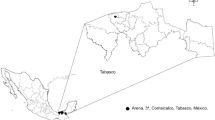Abstract
Polymerase chain reaction (PCR) was used to identify Rickettsia prowazekii, the etiologic agent of epidemic typhus. For the PCR, Thermus thermophilus thermostable DNA polymerase was applied with buffer containing a relatively low Mg2+ concentration (1.5–2 mM with dNTP's at 250 μM each). A primer pair used to amplify a 448-base-pair (bp) fragment of R. prowazekii genome was Anethesized on the basis of the DNA sequence of gene rpa14/16, coding for a precursor of the mature polypeptides of molecular weight (Mr) 14,000 and/or 16,000 (16kD) from R. prowazekii strain E. For determining the specificity of the primer pair, purified genomic DNAs of 16 rickettsial and 10 other bacterial strains were used.
Similar content being viewed by others
References
AniskovichL.P., EremeevaM.E., BalayevaN.M., IgnatovichV.F., ArtemievM.I., EmelyanovV.V. and SmirnovaN.S. (1989): Methods for purification of Rickettsia prowazekii separated from the host tissue: a step-by-step comparison - Acta Virol. (Praha). 33: 361–370.
AniskovichL.P., MotinV.L., BalayevaN.M. and SmirnovG.B. (1992): Cloning and expression in Escherichia coli of the 37-, 14-, and/or 16-kilodalton antigens genes from Rickettsia prowazekii strain E -Acta Virol. (Praha). 36: 90–102.
AzadA.F., WebbL., CarlM. and DaschG.A. (1990): Detection of rickettsiae in arthropod vectors by DNA amplification using the polymerase chain reaction -Ann. N.Y. Acad. Sci. 590: 557–563.
CarlM., TibbsC. W., DobsonM.E., PaparelloS.F. and DashG.A. (1990): Diagnosis of acute typhus infection using the polymerase chain reaction - Ann. N.Y. Acad. Sci. 590: 439–444.
DessoukyA.El., ManorE.A., LangeJ.V. and AzadA.F. (1991): Detection of spotted fever group rickettsiae in ticks from the North Sinai, Egypt. In: J. Kazar and D. Raoult (eds.), Rickettsiae and Rickettsial Diseases -Publishing House of the Slovac Academy of Sciences, Bratislava, pp. 383–388.
ErlichH.A. (1989): Polymerase chain reaction - J. Clin. Immunol. 9: 437–447.
ManiatisT., FritschE.F. and SambrookJ. (1982): Molecular cloning: a laboratory manual - New York: Cold Spring Harbor Laboratory, Cold Spring Harbor.
RegneryR.L., SpruillC.L. and PlykaytisB.D. (1991): Genotypic identification of rickettsiae and estimation of intraspecies sequence divergence for portion of two rickettsial genes - J. Bacteriol. 173: 1576–1589.
SaikiR.K. (1989): The design and optimization of the PCR. In: H.A. Erlich (ed.), PCR technology: principles and applications for DNA amplification. US & Can: Stockton Press, pp. 7–16.
TzianabosT., AndersonB.E. and McDadeJ.E. (1989): Detection of Rickettsia rickettsii DNA in clinical specimens by using polymerase chain reaction technology - J. Clin. Microbiol. 27: 2866–2868.
WebbL., CarlM, MalloyD.C., DaschG.A. and AzadA.F. (1990): Detection of murine typhus infection in fleas by using the polymerase chain reaction - J. Clin. Microbiol. 28: 530–534.
Author information
Authors and Affiliations
Additional information
To whom all reprint requests should be addressed.
Rights and permissions
About this article
Cite this article
Aniskovich, L.P., Motin, V.L., Lichoded, L.J. et al. Identification of Rickettsia prowazekii using the polymerase chain reaction. Eur J Epidemiol 9, 645–649 (1993). https://doi.org/10.1007/BF00211440
Issue Date:
DOI: https://doi.org/10.1007/BF00211440




